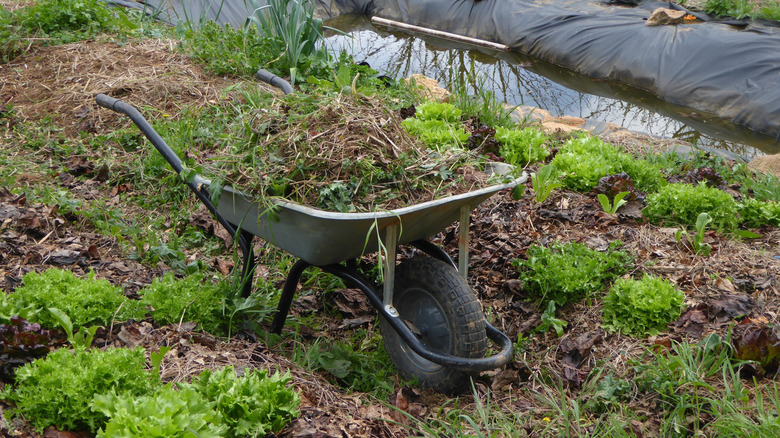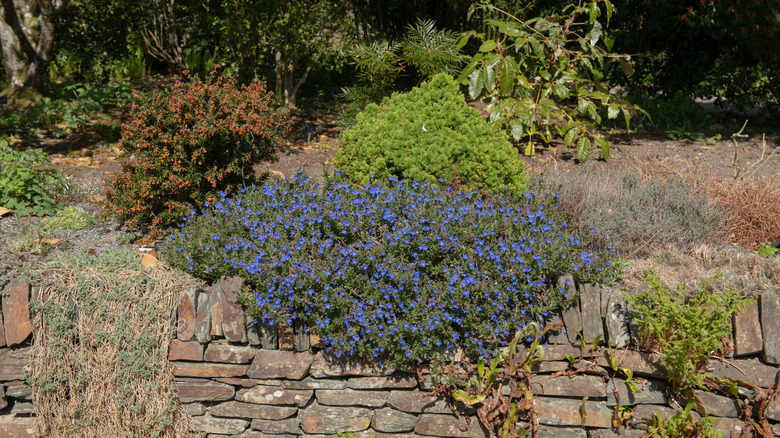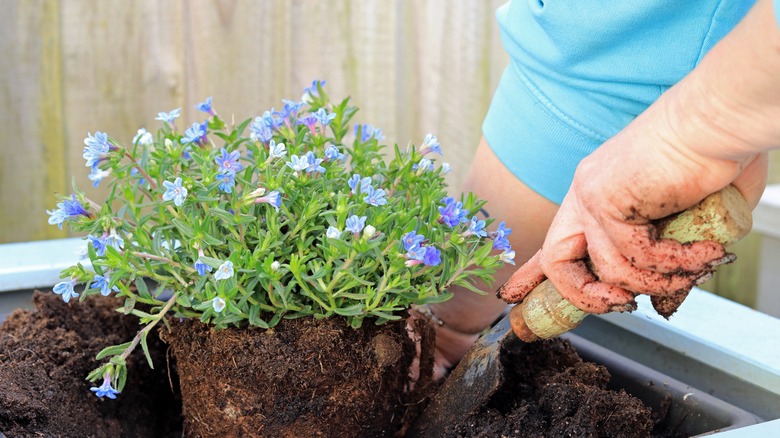Suppress Stubborn Weeds With The Help Of A 'Heavenly Blue' Flowering Groundcover
We may receive a commission on purchases made from links.
More often than not, the weed removal hacks you'll wish you tried sooner are surprisingly simple — pouring boiling water, vinegar, or diluted dish soap over weeds, smothering them with a plastic sheet, spraying some clove oil on them, etc. But arguably, the most green-thumbed, attractive, and minimal-effort option is preventing weeds from popping up in the first place by planting ground covers. Glendora prostrata 'Heavenly Blue' is a hardy, evergreen plant that spreads wide across a garden, smothering weeds and blessing the dedicated gardener with hundreds of brilliant azure blooms. Perhaps best of all, the plant requires little more than an annual trim and occasionally (maybe) some rhododendron and azalea fertilizer to maintain its weed-smothering prowess.
That Glendora prostrata 'Heavenly Blue' hails by a few common names — lithodora, shrubby gromwell, purple gromwell, creeping Glandora, scrambling gromwell among them — can confuse gardeners. It's commonly sold under the scientific name Lithodora diffusa, which is in fact the name of a non-cultivated shrub from the same region. As such, other synonyms to look out for at nurseries when buying this plant include Lithodora prostrata, Lithodora diffusa 'Heavenly Blue' and the former names Lithospermum fruticosum var. prostratum and Lithospermum prostratum. Native to the heathlands of France, Morocco, Portugal, Spain, and Turkey, it thrives in the harsh coastal Mediterranean climate. In the U.S., Glendora prostrata is considered a temperate groundcover; it grows in Hardiness Zones 5a through 8b in dry sandy or loamy soils — so much so that it's often named in lists of xeriscape plants. Bonus: Plants in this genus are also known to recover quickly from fire damage.
How Glandora prostrata keeps weeds at bay so successfully
Glandora prostrata rates so highly among the easy-to-grow ground covers to smother weeds in your yard and garden because the prostrate, clump-forming shrublet (or dwarf shrub) boasts branches dense with dark green and gray hairy leaves and, in the spring and summer, brilliant blue blooms. It grows at a moderate pace, forming a thick mat up to 30 or 36 inches around. What's more, this hardy perennial remains evergreen in warm winter climates. With little light making its way through the nearly impenetrable foliage, most weed seeds will fail to thrive. The roots of Glandora prostrata also thoroughly colonize an area, leaving little room for competition. In fact, you need to carefully dig out all the roots to remove it.
While it might seem that Glandora prostrata is the perfect weed-subduing groundcover, it does have some quirks you need to be aware of before running to your local nursery for a plug or three. It prefers a spot in full sun; if you plant this shrub in partial shade, it will become tall, straggly, and leggy with noticeable bare patches. This can also occur due to particularly cold temperatures and maturity. While pruning away woody stems after flowering ends in the late summer or early spring to remove winter damage can help, you might also need to dig up the plant and replace it every couple of years. It also prefers dry, acidic to mildly acidic soils, making it ideal for weed suppression in rockeries, retaining walls, borders, and around outdoor living areas, but not such a great option in damp or boggy spots or beds with alkaline soils.
Where to get Glandora prostrata 'Heavenly Blue' and alternative cultivars
With its vibrantly hued blooms and ability to get rid of weeds in a garden, the cultivar 'Heavenly Blue' is a favorite among gardeners and horticulturists alike. The plants typically start appearing at nurseries in the U.S. in March each year. The Home Depot sells 2.5-quart pots of Glandora prostrata (under the name Lithodora) for about $39, or you can get a packet of 200 Glandora Diffusa Seeds by YEGAOL Garden for about $12. Another Glandora prostrata with brilliant blue blooms worth considering is the slightly bushier but otherwise basically the same cultivar 'Grace Ward'. Wayside Gardens in South Carolina sells 1 quart pots of 'Grace Ward' gromwell for $15.
If you find the saturated blue blooms of either 'Heavenly Blue' or 'Grace Ward' a little too domineering in your garden design but love the Glandora growth habit, there are other options within the same family. Olive-leaved gromwell (Lithodora oleifolia) boasts pink buds that turn sky-blue when open, as does Lithodora Tidepool 'Sky Blue'. Glandora prostrata 'Star' or 'White Star' (purple gromwell 'Star' or 'White Star') has adorable periwinkle blue flowers with white borders, while the blooms of Lithodora diffusa 'Alba' (white gromwell) are, as the name implies, snow-colored. When your plants arrive from the nursery, be sure to wear gloves when planting them out. Glandoras can irritate the skin of some people. Plant them in a dry part of your garden and water infrequently. Pest-wise, you only really need to look out for aphids and spider mites. Finally, too wet conditions may lead to diseases caused by the mold-like Phytophthora and Pythium.


